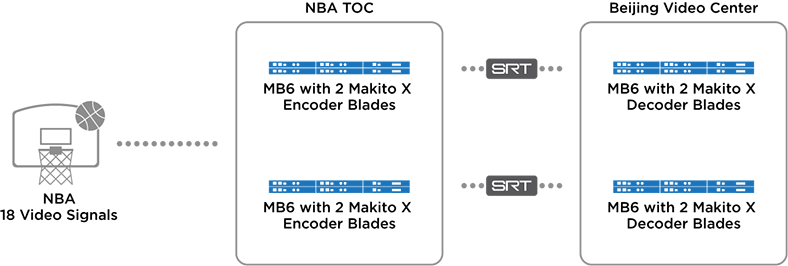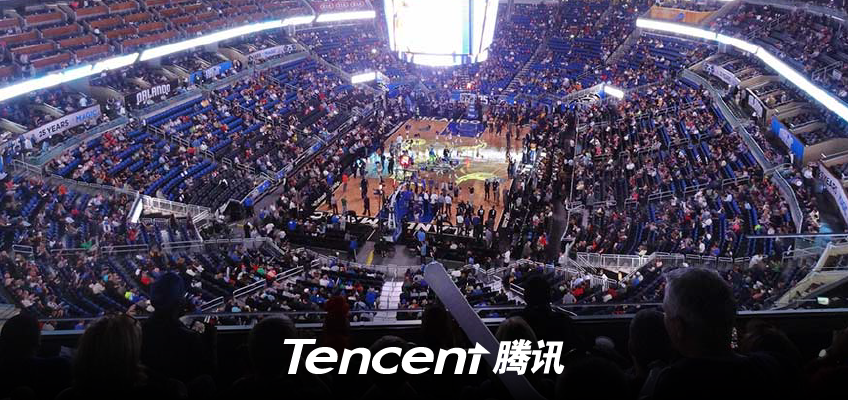You’re a streaming video service in China. You have a huge population of people who love NBA basketball. They want to watch the games live via a streaming service.
You’ve already got the infrastructure in place to stream massive amounts of video to an incredibly large audience. You just need to get the feeds from the United States to China.
You also need to make sure that when you’re sending the video, you’re not compromising the integrity and quality of the content from point A to B.
Oh, and one more thing!
You need to get the video there as quickly as possible so that your audience isn’t constantly getting spoilers from social media about what’s already happened in the game.
This is exactly what Tencent has done for their NBA League Pass customers in mainland China. How did they do it? And where does the demand come from? Let’s find out!
Who is Tencent and what do they do?
Most of you in the video streaming world will be familiar with internet juggernaut Tencent. Tencent Video is a division of the conglomerate, and has more than 40 million paying subscribers.
Tencent is also behind the massively popular app, WeChat. The group came very close to buying WhatsApp in 2014. When Facebook heard about the bid, they doubled the offer Tencent had made to make it a cool $19 billion dollar investment.
With all of this experience, infrastructure, and know-how, Tencent was the obvious choice when the NBA went looking for a partner for their NBA League Pass service in China.
The League Pass offers subscribers the opportunity to watch NBA games live or on-demand, with the only exception to the live rule being regional blackouts when there are conflicts with broadcasts from the home city of a basketball team. One presumes this does not happen in China.
What does happen, however, is massive audiences of people watching NBA via the live streaming video service. But what’s driving this demand?
The growth in popularity of the NBA in China
Basketball is by no means new to China. It was introduced in the country by missionaries soon after its invention in the late 19th century.
During the Cultural Revolution, despite the fact that anything Western was viewed as unsavoury, the game thrived. And as China progressed, opening up to the West in the 70s, the country got more and more interested in NBA basketball.
In 1987, NBA highlights could be seen on China’s state-run CCTV network, and the demand for broadcasts of NBA games has risen ever since. The estimated fanbase of the NBA in China now is somewhere around 450 million people.
The NBA opened a Weibo account in 2010, which now boasts more than 33 million followers. Just for comparison, this is six million more than the NBA’s global Twitter account.
During the 2016-2017 playoff season alone, that social media account racked up 2.9 million video views in the month of June alone. China is hungry for the NBA!
But what really fired up the NBA’s presence in China has been the contract signed between the NBA and Tencent Holdings Ltd to deliver live and on-demand NBA broadcasts over the internet.
For an online broadcaster in China to be able to get feeds from the US and stream them live to their millions of viewers requires a little bit of technology. But not as much as you might think.
Sending high-quality video 10,000 miles
As those of you who have seen maps before are aware, there is a bit of distance between New Jersey, where NBA’s headquarters are, and China, where Tencent’s viewers are.
The first thing that had to be worked out was how to get the video from the NBA Technical Operations Center in Secaucus, New Jersey to the Tencent broadcast center in Beijing, China.
While by no means as arduous, or even as cute, as the trek made by the lovable pets in The Incredible Journey, the passage is still rather remarkable. From the broadcast center in Jersey, the video travels through a local telecom, finds its way to submarine fiber where it barrels along the ocean floor before making land in China, where it again travels through local internet systems to the Tencent broadcast center—a journey of more than 10,000 miles.
The concern that Tencent had was that, in the beginning, they were losing quality along the way in the form of packet loss and jitter.
“Haivision’s SRT technology is impressive. Other vendor’s performance could not compare with this protocol’s stability and reliability.” Tracy Wen, Senior Engineer – Tencent Video
Tencent had already begun their NBA initiative when they reached out to Haivision. They were using a workflow that had not yet met their expectations in terms of video quality, and were seeking a solution with strong error correction capabilities.
Tencent knows how important it is to offer HD content to their viewers, and they’ve been able to achieve that by using a configuration of Haivision Makito X encoders and decoders to help them transport the NBA video feeds over that incredibly long distance while still maintaining the quality of the original feed.
They use a series of 18 pairs of Makito X encoders and decoders to get the job done right. See the diagram below to check out the workflow.

What’s fuelling the consistent, high-quality video delivery is Haivision’s Secure Reliable Transport (SRT) protocol (an open-source protocol developed by Haivision, with an alliance boasting more than 100 members). SRT’s packet recovery is incredibly robust, maintaining the integrity of the video while at the same time delivering the video with extraordinarily low latency.
Since the implementation of this new workflow, Tencent has actually been able to actually reduce its operations costs. They transport the video over low-cost internet connections, but actually end up with a better product than what they had before making the switch to Makitos.
Much like the 2015-16 Golden State Warriors in the regular season, it’s nothing but winning for Tencent and their wildly popular NBA live streaming feeds!
It’s a pleasure to be a part of this endeavour, and to be an integral aspect of the system that means so much to so many people.
Ready to learn more? Here is a list of things that you can do right now to get more information.
Learn more about SRT’s open-source video streaming protocol by clicking here.

